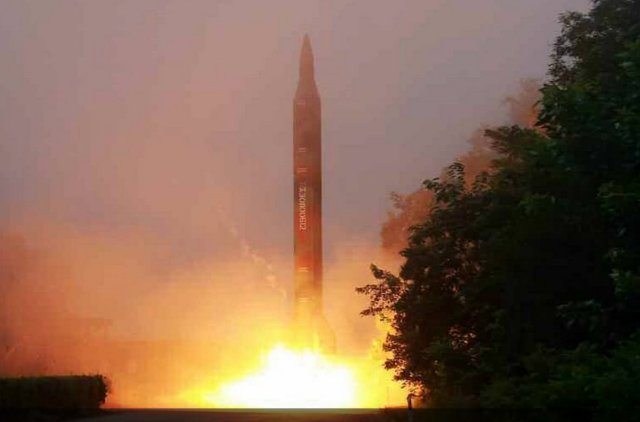Breaking news
North Korea test-fires three Rodong ballistic missiles into Sea of Japan.
| a | |||
|
|
|||
|
Defence & Security Industry News - North Korea
|
|||
|
|
|||
|
North Korea test-fires three Rodong ballistic missiles into Sea of Japan
|
|||
|
The Democratic People's Republic of Korea (DPRK) on Monday test-fired three ballistic missiles into eastern waters ahead of the country's National Day, South Korea's defense ministry said. A defense ministry official told Xinhua that the missiles were launched into the East Sea at about 12:14 p.m. local time from its western areas near Hwangju county in North Hwanghae province.
|
|||
|
|
|||
 A photo released on July 20 by North Korea's state-run Rodong Sinmun newspaper showing a ballistic missile being fired during a drill at the Hwasong artillery units of the North Korean Army's Strategic Force (Credit: ZUMA PRESS) A photo released on July 20 by North Korea's state-run Rodong Sinmun newspaper showing a ballistic missile being fired during a drill at the Hwasong artillery units of the North Korean Army's Strategic Force (Credit: ZUMA PRESS) |
|||
|
|
|||
|
Those missiles, which are believed to have been Rodong mid-range missiles with a range of 1,000 km to 1,200 km, traveled about 1,000 km toward Japan.
Yonhap news agency reported that those missiles landed in Japan's air defense identification zone. The DPRK hadn't issued a navigation warning before the test-firings, according to South Korea's Joint Chiefs of Staff (JCS). Seoul's military authorities had already detected preparations for Pyongyang's ballistic missile launches, according to the Yonhap report. Concerns emerged about possible DPRK provocations ahead of the 68th anniversary on Friday of the founding of the state. In 2014, Pyongyang conducted two rounds of short-range missile launches before the National Day. The defense ministry official said over the phone that the military has been closely monitoring DPRK troops. Seoul's military said Monday's test-launches were an apparent armed protest to maintain military tensions on the Korean Peninsula by showing off its nuclear and missile capabilities ahead of the National Day holiday. The missile launches came less than two weeks after Pyongyang test-fired a ballistic missile from a submarine off its east coastal town of Sinpo, where a submarine base is known to be located, on Aug. 24. The submarine-launched ballistic missile (SLBM) flew some 500 km eastward, falling inside Japan's air defense identification zone for the first time. Three Rodong ballistic missiles, fired by the DPRK on Aug. 3, also fell into Japan's exclusive economic zone (EEZ). The SLBM test was conducted in an apparent show of force toward the annual U.S.-South Korea military drills, codenamed Ulchi Freedom Guardian (UFG), which had run from Aug. 22 to Sept. 2. The DPRK denounced the computer-simulated exercises as a dress rehearsal for northward invasion. Tensions are also running high in the region and on the Korean Peninsula as Seoul and Washington agreed on July 8 to deploy a U.S. missile shield in South Korean soil by the end of next year. The two allies claimed that one Terminal High Altitude Area Defense (THAAD) battery, presumed to be installed in southeastern South Korea, could protect against what they claimed was the DPRK's nuclear and missile threats. However, China and Russia have strongly opposed the deployment. |
|||




























